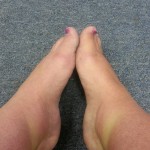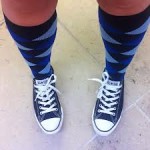I have talked about the benefits of drinking water throughout the day before; and it’s something that I practice on a daily basis. But one thing I’ve never discussed is when your body starts to retain some of that water in your legs or feet. We aren’t camels – this isn’t normal. It can be very painful and uncomfortable if not handled properly.
Though water retention is most common in pregnant women (don’t get me started on my oopa loopa feet from my pregnancy days) and older folks, it can happen to any of us. I work at a desk 5 days a week 9+ hrs a day. When I am drinking a ton of water sitting at a desk all day, it all goes straight down – yes, these puffy Flinstone feet below are mine. Swollen, painful, and ugly! This is actually not too bad it’s still early in the day and the later it gets the worse my ankles/feet get!
Ready to get my cute ankles back (so I can actually see a difference between my leg and my foot), I’ve decided to take action! Below are some great tips to help get rid of that extra water!
Step 1
Raise your legs above the level of your heart when you are lying down. Place one or two pillows under your heels and lower legs.
Step 2
Engage in regular exercise to keep fluid pumping back to your heart from your legs. If you suffer from heart disease or another medical problem, consult your doctor before beginning a new exercise program.
Step 3
Drink extra water to relieve legs that are retaining water. While it may seem counterproductive to increase water intake when you are trying to reduce water retention, drinking extra fluids actually helps by flushing sodium and other toxins from your tissues.
Step 4
Reduce the amount of sodium in your diet by limiting your use of table salt, skipping processed meats and foods, and choosing low-sodium food options when they are available
Step 5
Wear compression hose to improve the circulation in your legs, and avoid wearing clothing that fits tightly around your ankles or waist.
Step 6
Take frequent breaks to get up and move around when working at the computer, riding in a car, flying on a plane or sitting for prolonged periods for other reasons.
Step 7
Lose weight if you are overweight or obese. Being overweight interferes with circulation and forces your heart to pump harder to circulate fluids from your legs back to your heart.
Step 8
Speak with your doctor about medications you are taking that may be contributing to water retention in your legs. A change in medication or dosage may be helpful. Do not stop or adjust your medications without your doctor’s permission
**Water retention in the legs, ankles and feet is usually painless and treatable with home remedies. Fluid retention increases with age and is more common in those who are obese or suffer from impaired circulation. It may also be a sign of a serious underlying medical condition, such as kidney, liver or cardiovascular disease. For this reason, it is important to speak with your doctor about any new or worsening leg swelling, even if you appear to be in otherwise good health.











Great info! A lot of peeps don’t realize what water retention does to them.
great info!! Thanks for sharing, I have been thinking about compression socks and wondering if they were worth it.
those are some great tips! thanks for the post i plan to practice this
I love these tips! Thank you so much!!